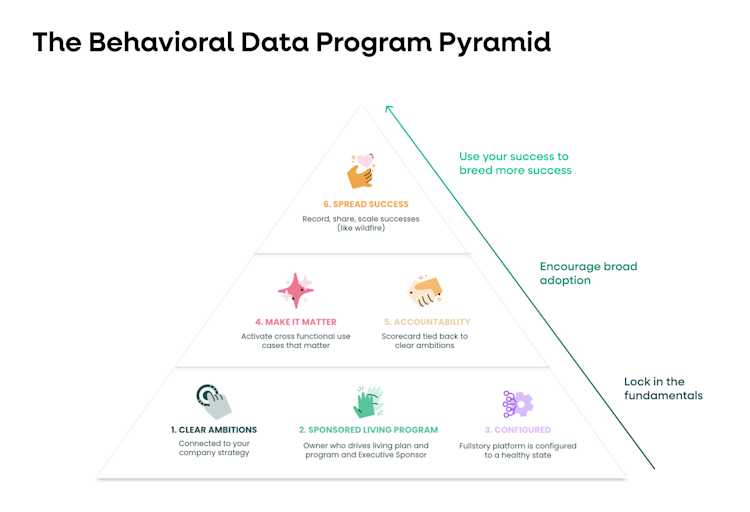Happy customers are the lifeblood of any successful business, and to keep them satisfied, you need data that reveals more than surface-level information. Behavioral data offers insights that go beyond who users are and where they're located. It uncovers the why behind every digital interaction, empowering organizations to create better experiences, quickly iterate on products, and ultimately build lasting customer loyalty.
However, wanting to leverage behavioral data and actually leveraging behavioral data are two different things.
Leveraging behavioral data requires more than investing in a tool and passively observing the data flow; you need a programmatic approach that encompasses sponsorship, collection, analysis, and practical application.
Benefits of implementing a structured behavioral data program
By implementing a behavioral data program, you can achieve transformative outcomes that significantly impact your organization’s bottom line, such as:
Enhanced customer experiences: Better understand the sentiment behind user actions, helping you create more intuitive and enjoyable experiences that keep customers returning.
Faster innovation: Rapidly iterate and test ideas, allowing your organization to identify improvements for your products or services quickly.
Data-driven decision-making: Drive more accurate strategies and improved outcomes. A well-executed program ensures this capability is embedded across the organization.
Competitive advantage: Give your organization a distinct edge in understanding and meeting customer needs, helping you stay ahead of market trends and outpace competitors who rely on more limited data sets.
The behavioral data program pyramid
Imagine a pyramid that represents your behavioral data program. At the base, you have the foundational building blocks—the essential elements that support everything else. In the middle, you'll find strategies for encouraging broad adoption within your organization. At the peak, you have methods for spreading success and scaling your program's impact.
This pyramid structure illustrates a step-by-step approach to building a behavioral data program. Let's explore each level in detail, starting at the bottom.
The base: Laying the foundation for a successful behavioral data program
At the base of our pyramid are the foundational elements that support the entire behavioral data program. These building blocks are crucial for creating a stable and effective framework that empowers teams to adopt and leverage behavioral data, replicate successes across departments, and drive measurable business outcomes.
Clear goals aligned with company strategy
First, you must establish clear ambitions that align with your company's overall strategy. Alignment to business goals ensures that your behavioral data program isn't just a standalone project, but an integral part of your company's growth strategy. Ask yourself:
What are we trying to achieve with our behavioral data program?
How does this initiative contribute to our organization's bigger picture?
What specific outcomes are we aiming for?
By answering these questions, you'll create a solid foundation for your program and secure the sponsorship and resources needed to drive a living, evolving data initiative.
Dedicated program owner and executive sponsorship
Designate a dedicated program owner who will:
Continuously connect the behavioral data program to business ambitions
Maintain enthusiasm and momentum for the project
This passionate program owner will be the driving force behind your behavioral data program, ensuring it remains dynamic and responsive to changing business needs.
You also need executive sponsorship. Having a high-level champion for your behavioral data program is crucial for its success and longevity. This sponsor acts as a bridge between the program and the highest levels of the organization.
An effective executive sponsor should:
Communicate the benefits and power of behavioral data to other executives
Help stakeholders understand how behavioral data equips them with valuable insights
Evangelize the program's successes and potential across the organization
Strong executive sponsorship paves the way for expanded use cases and enables behavioral data to be leveraged in numerous ways throughout the company.
Correctly configured tooling
The final building block in our foundation is configuring your tooling correctly. Proper configuration involves thoughtfully setting up your data management approach.
For example, you'll need to establish a system for naming your pages, set up watched elements, and define what constitutes a revenue event. It's also crucial to configure your privacy and data capture settings to align with your company's preferences and compliance requirements.
Lastly, set up your first round of integrations to bring behavioral data to where your users interact on a day-to-day basis. This foundational configuration ensures that you're capturing the right data and making it accessible in the most relevant contexts for your team.
The middle: Encouraging broad adoption
The middle section of our pyramid is focused on encouraging widespread adoption across the organization. This phase is critical for maximizing the value of your behavioral data program and ensuring its impact is felt throughout the company.
Make it matter
To drive adoption, you must demonstrate the relevance and value of behavioral data to each department. This involves more than just presenting data; it requires showing how this information can directly impact and improve each team's performance and outcomes.
To make behavioral data matter to different departments:
Understand the specific goals and challenges of different teams
Illustrate how behavioral data can help them achieve their objectives
Provide concrete examples of how the data can inform decision-making
By tying everything back to not only wider business ambitions but also specific departmental goals and needs, you'll create a compelling case for cross-functional usage and adoption.
Once you have additional departments bought into the value the data can provide, ensure you actualize these use cases within your behavioral data platform.
Establish accountability
Implementing a behavioral data program isn't a set-it-and-forget-it endeavor. To ensure ongoing success and demonstrate the program's value, it's crucial to establish clear accountability measures. Consider creating a simple scorecard that:
Documents your goals
Identifies key success metrics
Tracks progress over time
This accountability framework will help keep the program on track and provide tangible evidence of its value to stakeholders, further encouraging adoption and investment in the program.
The peak: Spreading success
The top of the pyramid is about maximizing the ripple effect of the successes you’ve revealed with behavioral data, ensuring they don’t just stay confined to one team or project but instead become the catalyst for broader organizational growth.
Use your successes to breed more success
When those initial wins start to materialize, be sure to share them across your teams. This broader sharing helps:
Demonstrate the tangible value of behavioral data
Inspire other teams to explore how they can leverage the data
Create a culture of data-driven decision-making
You might consider creating case studies or playbooks or offering training sessions or workshops to facilitate the replication of your wins.
Unlock the full potential of data with Fullstory
Building a structured behavioral data program is a journey that requires careful planning, consistent effort, and ongoing commitment. By following the pyramid structure outlined above, you can help your organization unlock the full potential of behavioral data.
Are you ready to take the next step in your behavioral data journey? Stop letting valuable insights slip through the cracks. Learn how Fullstory can empower your organization to make data-driven decisions, drive meaningful change, and delight your customers here.


